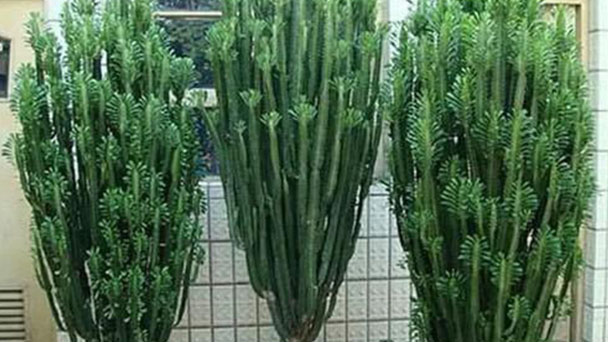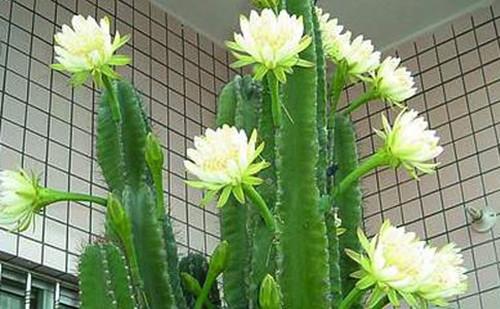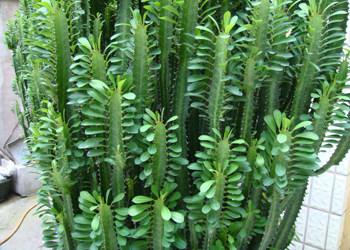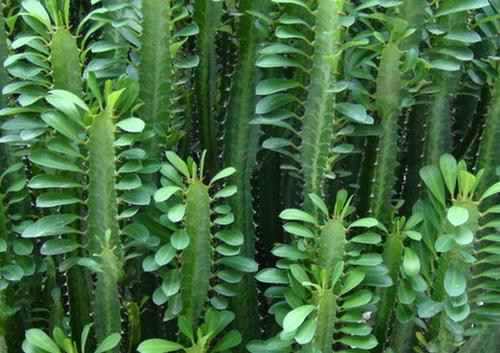African Milk Tree (Euphorbia Trigona) Profile: Plant Facts, Care & Propagation Guide
Written by Maggie
Jan 07 2023

It's simple to take care of African milk tree plants. The African milk tree enjoys direct sunlight that is bright. For indoor gardening, choose a window that faces south.
African Milk Tree (Euphorbia trigona) is three-sided, multi-branched, blue-green, 4 to 5 meters high, with small thorns on the edges, and very short. African Milk Tree with 4 to 9 white flowers in summer, clustered in the upper prickles, bloom at day and closed at night (potted plants are not easy to flower), small round berries, blue purple, edible. The whole plant is sweet white milk, toxic.
African milk tree is cactus family, dragon, the plant is three-pronged, much branched, bluish green, 4 to 5 m tall, edges with small thorns, very short. african milk tree column is known as "universal rootstock". Using african milk Tree columns as anvil, it can be grafted with tiger plum and crab claw orchid, with strange flowers and different trees, which are colorful. The following are details African Milk Tree basic info, care and propagation guide.
African Milk Tree Picture

What is An African Milk Tree?
The African milk tree (Euphorbia trigona) is a succulent plant native to Although it is not a cactus plant, but rather a tall-growing, multi-branch succulent, it is known by many other names, including candelabra cactus, cathedral cactus, good luck cactus, and friendship cactus.
The African milk tree has branches that grow upward and produce white sap; it has thorns and small oval-shaped leaves which may be green or, in the case of Euphorbia trigona ‘Rubra, a brilliant red also known as "Royal Red." In succulent gardens with the right outdoor conditions, african milk trees can grow as tall as six feet. The African milk tree makes a perfect low-maintenance indoor plant because of its slow growth.
African Milk Tree Info
| Botanical Name | Euphorbia trigona |
| Common Names | African Milk Tree, African Milk Bush |
| Plant Type | Succulent |
| Sun | Indirect sun to partial shade |
| Hardiness Zones | 9b to 11 |
| Bloom Time | Summer |
| Flower color | White |
| Native Area | Central Africa |
| Mature size | 6 to 8 feet |
African Milk Tree Morphological Characteristics
African Milk Tree is tri-ribbed, much branched, bluish-green, 4 -- 5 m tall, prickly, very short. African Milk Tree with 4 to 9 white flowers in summer, clustered in the upper prickles, bloom at day and closed at night (potted plants are not easy to flower), small round berries, blue-purple, edible.
Stems of African Milk Trees are elongated, ca. 8 m or longer, climbing on shrubs or trees or walls by aerial roots, green, fleshy, often contracted into nodes, with 3 broad ridges and undulating edges. Leaves are degenerate, in the edge axillary between the fossa hole, the distance between fossa holes 4 ~ 5 cm, there are 1 ~ 3 spines. Flowers are solitary, open at night, closed during the day, 25 -- 30 cm long; Calyx is petalate, yellow-green, lobes thick, lanceolate, exserted, calyx tube large scales, without spines; Petals of African Milk Tree are pure white, erect; Stamens are numerous, 2 columns, milky white; Ovary is inferior, style 1, stigma split, lobes milky white.
African Milk Tree fleshy berry oval, ca. 10 cm long, red, scaly, nearly smooth when ripe. Flowering in summer and autumn. Growing on waste walls or trees, cultivated in gardens.
African Milk Tree Ecological Habits
African Milk Trees are not cold-resistant, but drought-resistant, and like dry loam soil. It should be planted indoors in winter in the north, and can be planted on the open ground in the south, or used as a fence, which is both a green barrier and can beautify the courtyard. In summer, you can also enjoy the fragrance of flowers and fruits.
African Milk Tree column is known as "universal rootstock". Using African Milk Tree columns as anvil, it can be grafted with tiger plum and crab claw orchid, with strange flowers and different trees, which are colorful.
African Milk Tree does not require strict culture soil, but it needs to add a certain amount of river sand. If some base fertilizer is mixed in the pot, African Milk Tree can grow well without applying top dressing fertilizer during the growth period, and granular compound fertilizer is the best fertilizer. For drought has a certain tolerance, watering to the right amount, long-term in the wet state will cause root rot. In the indoor decoration, should be placed as far as possible near the sun's window side. African Milk Tree should be bred in moderate shade in the summer and exposed to more sunlight at other times.
Winter can withstand the lowest temperature of 5℃. African Milk Tree is propagated by cutting method. From spring to autumn, 5cm to 6cm of the top of the mother plant is cut as cuttings. The cuttings are dried in the shade for a week and then cut out after the cut is fully dried, which is easy to root.
- Also Read: How Big Do Succulents Grow
African Milk Tree Care
Soil
After rooting, transplanting was carried out. The pot soil required 1/2 river sand and 1/2 loam soil to be mixed and then planted in, and poured in with 2% potassium permanganate water. The soil was disinfected and watered.
Light & Watering
When the culture place in the sun, African Milk Tree still needs to control the amount of water, prefer to dry some and not be too wet. African Milk Tree is not cold resistant, but drought-resistant, and like dry loam. It should be planted indoors in winter in the north, and planted in the open field in the south. There are a variety of African Milk Tree columns, such as clump, three-column, nine-column and so on.
Temperature & humidity
This drought-tolerant plant enjoys a dry or arid climate, and can tolerate fairly hot temperatures. It doesn't survive the cold though, and won't flourish if temperatures go below 55 F. If grown in a place with very hot summers, the plant should be located in a spot with indirect sunlight or partial shade, to avoid overheating. This plant doesn't need any extra humidity, and growing it in an environment that is too humid may cause issues such as fungus or pests.
Repotting
If the plant is growing fast and its current container is not size-appropriate anymore, it is recommended to repot African Milk Tree in spring. Most Euphorbia Trigonas will require repotting every two years.
When the African Milk Tree becomes large, you might find it a bit difficult to handle. So, instead of repotting it, you can simply change the top few inches of soil with a fresh one every spring.
Pruning
For African Milk Tree propagated by cutting, when it grows to about 10-15cm, it is necessary to prune the top of the African Milk Tree plant to help better branch growth, so that the shape of the plant will be better. In addition, when repotting African Milk Tree, properly trim the rotten root system, and apply some grass and wood ash after pruning to help the wound dry and heal faster. If left untreated, the wound will rot easily.African Milk Tree Propagation
African Milk Tree is a multi-pulp plant, which is usually propagated by cutting. When cutting, slurry will flow out. It can be closed with plant ash, put in a cool place for 7 to 10 days, and then cut after the plant atrophies.
One is to cut African Milk Tree cuttings. Both upper and lower cuts should be sealed with plant ash. The length of cuttings should be 20cm to 25cm.
The other is the branch taken from the African Milk Tree, which can be cut after drying. However, it is not easy to take root if it is too small and tender. This kind of cutting only has small wounds at the root place, so the cutting takes root quickly. Vermiculite, pearl powder, pure river sand and no soil are required for cutting African Milk Tree substrate. African Milk Tree can be single cutting, can also be more than one plant cutting, after watering, pouring only to cuttings incision, put a sunny place. Rooting period as little as possible watering, not watering, for 30 to 40 days, you can root.
After taking root on the African Milk Tree column, transplant it. The pot soil should be mixed with 1/2 river sand and 1/2 loam soil, and then planted in with 2% potassium permanganate water. The soil was disinfected and watered, and the height of the plant could be fixed with a stick. Put the culture in a sunny place, still need to control the water, prefer dry rather than wet is better.

African Milk Tree Disease Control
African Milk Tree column insect pest is less, indoor ventilation is poor, easy to be harmed by red spider top, found that the top of the branch is reddish brown, there is net, can be used 1000 times to 2000 times oxidized diethoate spray cloth, the dosage should not be too large, to prevent head ulceration.
African Milk Tree Uses
Ornamental Value
There are a variety of African Milk Tree columns, such as clump, three-column, nine-column and so on. The concrete method of reshaping is as follows: when the nine-pillar plants grow to 20cm to 30cm, cut off the top with a sharp knife, and seal it with plant ash immediately. When the African Milk Tree branch out, only the three branches at the top should be kept, one at each corner, and the rest should be wiped off. When the second layer grows to 25cm to 30cm, cut off the top of the second layer. Once the branches are grown, choose three branches again, three for each corner, that is, African Milk Tree in the shape of 1, 3 and 9.
The same method is used for the 12-column, but when the 9-column grows to 20cm to 30cm, the top is cut off, and then the three branches are grown, 1 or 3 for each corner. The rest of the small branches, as long as the removal, to maintain the same tree shape.
Potted African Milk Tree
When the African Milk Trees grow to 40cm to 50cm or 30cm to 40cm, cut off the top and let them grow naturally to form a polycephalous African Milk Tree. However, the selection should be orderly and not disorderly.
When the African Milk Tree column grows to a height of 2 to 3 meters, it forms many branches, which are easy to cause top-heavy and unstable. Therefore, it should be fixed with a stick in time. African Milk Tree should be sunny. African Milk Tree branches are blue-green and its leaves are like fish scales, which will shine brightly in the sunlight. There are numerous trees with sharp swords and peaks, which are very spectacular.
Household African Milk Tree
African Milk Tree, in the application of home furnishing, not only has the effect of removing evil spirits, but also has a good purification effect. For the newly decorated house between the family and the office building, it has a good adsorption effect on formaldehyde, benzene, radon, ammonia and TVOC.
However, it is necessary to pay more attention to planting African Milk Tree indoors, because there are sharp spines on the fleshy stems of African Milk Tree, and the white milk in the stems is poisonous, especially not to the eyes. Therefore, it is necessary to pay special attention to the location of planting African Milk Tree at home, so as to avoid puncturing and poisoning by children and the elderly. Furthermore, African Milk Tree flowers are resistant to drought and sunlight, and are suitable for sunny places rather than dark places indoors. Therefore, African Milk Tree flowers placed indoors for viewing should be placed near the window of sunlight as far as possible.
The flowers of African Milk Tree are big and dominions, and African Milk Tree belongs to the cactus family. Cactus gives people the impression that it is a plant with strong vitality growing in the desert.
Landscaping
African Milk Tree is not cold resistant, but drought-resistant, and likes dry loam soil. It should be planted indoors in winter in the north, and can be planted on the open ground in the south, or used as a fence, which is both a green barrier and can beautify the courtyard. In summer, you can also enjoy the fragrance of flowers and fruits.
African Milk Tree has many branches and is vertically upward, giving people the feeling of being straight and upright. It can be cultivated into plants of different sizes and planted with flower pots of different specifications to decorate halls, bedrooms and meeting places, etc. It can also be planted together with other cactus and succulent plants to make combined bonsai for better ornamental effect. In addition, can also be planted on the ground, for the garden department layout of desert plant landscape, as a background material, especially suitable.
African Milk Tree has beautiful shape, green branches, neat leaves and fish-like leaves, which will shine in the sunlight. With numerous bodies and sharp swords on the peaks, African Milk Tree is very spectacular. It is a good choice for pot flowers.Potted plants can decorate the living room, balcony, courtyard and other places.
African Milk Tree Toxicity
African Milk Tree has sharp thorns on its fleshy stem, and the white milk in the stem is poisonous, especially not to the eyes. Therefore, in family culture, special attention should be paid to the proper place to avoid puncturing and poisoning by children and the elderly. The African Milk Tree in my family has been kept for three years, but it has not been changed. It is about one meter high and its flowers are growing well. The pot is 26cm in diameter. Change the size of the pot. Change it every two years. African Milk Tree does not have many roots, so the size of the pot is suitable for the proportion of the plant. Is African Milk Tree poisonous? The SAP of African Milk Tree is poisonous. As long as the branches and leaves are not broken, the milky white SAP will not flow out. If you accidentally touch it, you must wash your hands immediately and do not take it into your mouth, because some people have tried it, and your mouth will be numb soon after taking it into your mouth.

Are African Milk Trees Toxic?
African milk tree sap is toxic and can irritate the skin and eyes. It is white and milky in appearance. When working with the plant, exercise caution and think about donning gloves. After pruning, wash your hands immediately, and keep kids and pets away from the plant.
Overwintering
Cold weather will kill African milk trees. It's important to plant them in the ground only if your climate permits since they typically won't thrive in temperatures below 50 F. When temperatures drop, potted plants must be brought inside. To reduce humidity, put your succulent in a room with good air circulation, and place it in a window with bright lighting and indirect sunlight.
Blooms
Sometimes you'll be surprised by the summer blooms that Euphorbia trigona produces. These succulents must either be large (taller than 3 meters) or mature (older than 20 years) in order to flower.
In controlled indoor environments, flowering hardly ever takes place. Increase your chances by closely replicating their natural environments and maintaining their health over the years.
African milk trees don't require blooms to be beautiful. They produce enough striking leaves that emerge from the ridges. But this probably isn't the best option if you really want a blooming succulent.
Common Problems With African Milk Tree
Stem Rot
Wet and humid conditions will cause your african milk plant to get stem rot. The most typical error with these succulents is to water them before the soil has completely dried out, but this is easily avoidable.
It's too late to save the plant once stem rot has set in. It will pass away days after displaying symptoms. However, by following the guidelines in the propagation section, you can begin a new plant from a healthy cutting.
Pests – Mealy Bugs and Spider Mites
Healthy Euphorbia trigona have a high level of pest resistance and are rarely bothered. They might become susceptible to pests like mealy bugs and spider mites in less than ideal conditions (like high humidity).
Both of these won't kill the succulent, but it's best to treat them right away to prevent them from spreading to other plants.
Wipe these pests off with a paper towel dipped in isopropyl alcohol as soon as you notice the infestation to get rid of it.
If you prefer organic neem oil, be sure to keep your succulent out of direct sunlight for a few weeks after applying it. Neem oil can result in some burn damage when combined with bright light.
Tips for Growing the African Milk Tree
Please don't overwater your African milk tree—I know it can be difficult to resist giving your favorite houseplants extra care.
Overwatering can be fatal and is almost always fatal. By keeping the area dry and watering sparingly, you can avoid this.
Another important piece of advice is to avoid having a heavy top. If the top of an Euphorbia trigona plant becomes overly bulky and unstable, its shallow root system is easily uprooted.
Don't forget to put on safety gear when handling and pruning the succulent.
Frequently Asked Questions About African Milk Tree
Is the White Sap from African Milk Trees Toxic?
Yes, the white liquid that resembles latex is poisonous and highly irritant to the skin. When working with the plant, heavy-duty gloves and goggles are recommended.
Are African Milk Trees Safe to Have Around Pets?
The majority of animals are aware that they should avoid the African milk tree's prickly ridges. Extremely inquisitive animals that persistently challenge the plant may require additional dissuasion. You can carefully cut off the spines if a quick jab from the plant doesn't persuade them to leave it alone.
The succulent won't be harmed, but this may temporarily slow growth. If sap leaks out, be sure to wipe it off immediately to avoid having it contact your skin. To stop infection, apply cinnamon to the wound after the white sap stops oozing.
Are African Milk Trees Really Trees?
African milk trees are not succulents. They are called cactus trees because of the way their stems develop, which gives them that appearance.
Conclusion
African milk trees are succulents that resemble cactuses and develop into trees. The plant appears to be dancing thanks to the leaves that sprout from the ridges. Check out the Royal Red variety if you're looking for a particularly beautiful cultivar.
Fast-growing and incredibly simple to maintain, this odd-looking plant. They will be noticeable and add some intriguing texture to your area of desert plants.
Give them a good home with a sandy soil mixture and well-draining pot, place them by a window that gets plenty of sunlight, and water them infrequently.
You will be rewarded with a huge, flourishing houseplant if you largely ignore Euphorbia trigona.
Latest Updated
- Benefits of Bugleweed - 7 Science-backed Health Benefits
- Bugleweed Dangers & Side Effects - Is It Poisonous?
- How to Plant Evergreen Trees - What You Should Know
- When to Plant Evergreens - Grow Guide for Evergreen Trees
- 12 Wonderful Evergreen Shrubs for Your Garden
- 12 Popular Evergreen Plants with Pictures for Beginners
- When And How To Prune A Lilac Bush Like a Pro
- How to Grow & Care for Lilac Vine (Hardenbergia Violacea)
- Japanese Lilac Tree (Syringa Reticulata) Care & Propagation Guide
- Shumard Oak Pros and Cons - What to Know
Popular Articles
- Winter maintenance of Antirrhinum Majus
- How to Grow Terminalia Mantaly Tree
- How to Grow and Care for Crossostephium Chinense
- How to grow Antirrhinum Majus in spring
- Peristeria Elata (Dove Orchid) Profile: Info & Care Guide
- Underwatered Snake Plant (Sansevieria Trifasciata) - Signs And How To Fix
- How to Care for Brazilian Jasmine Plant (Mandevilla Sanderi)
- How to Grow & Care for Graptopetalum Purple Delight in Summer
- Rosa Chinensis (China Rose): Plant Growing & Care Tips
- How to Care for Baby Sun Rose (Aptenia Cordifolia)